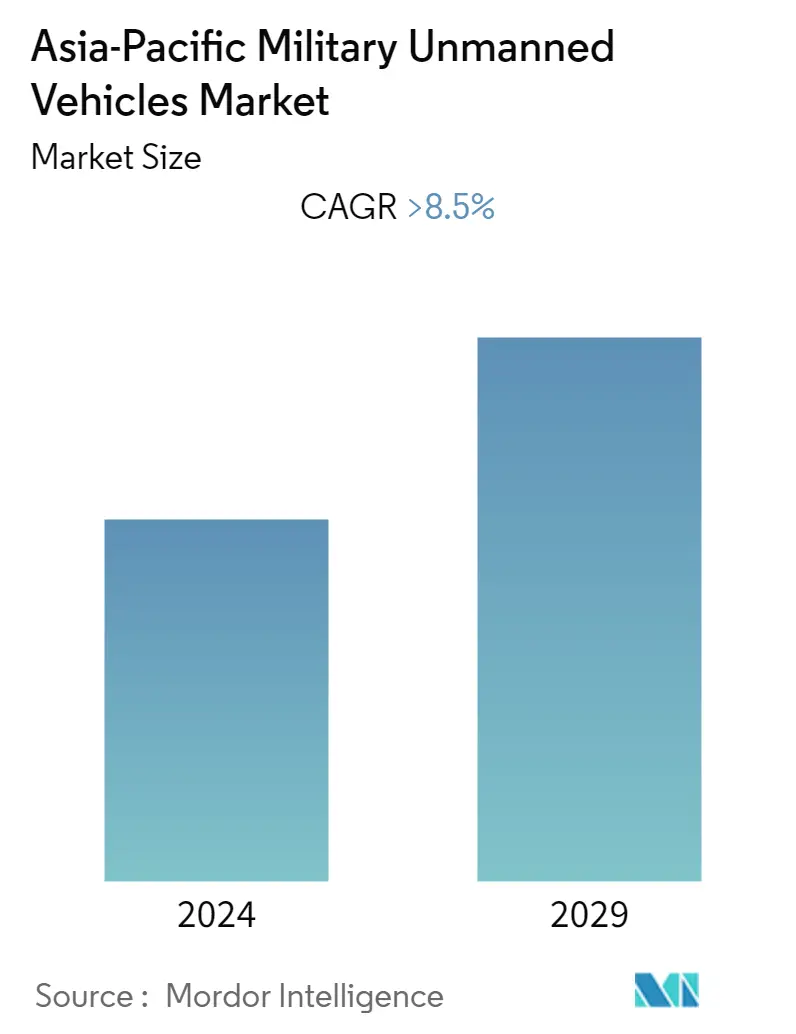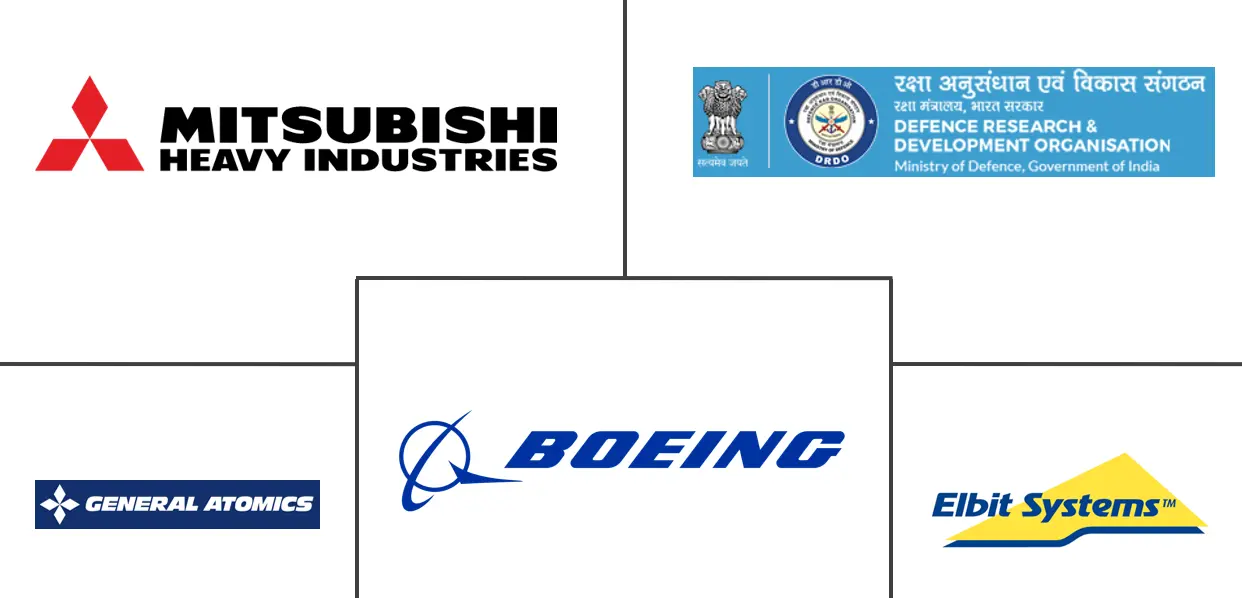Market Size of Asia-Pacific Military Unmanned Vehicles Industry

| Study Period | 2019 - 2029 |
| Base Year For Estimation | 2023 |
| Forecast Data Period | 2024 - 2029 |
| Historical Data Period | 2019 - 2022 |
| CAGR | > 8.50 % |
Major Players
*Disclaimer: Major Players sorted in no particular order |
APAC Military Unmanned Vehicles Market Analysis
The Asia-Pacific military unmanned vehicles market is expected to record a CAGR of 8.5% during the forecast period 2022-2031.
The impact of the COVID-19 pandemic on the Asia-Pacific military unmanned vehicles market was negligible as the investments by countries in the region toward the development and acquisition of new unmanned vehicles for combat and non-combat missions remained unaffected.
Due to the ongoing border tensions and geopolitical issues between neighboring countries in the region, the military expenditure of the countries has increased robustly over the past decade. The growing military spending is fueling the procurement and induction of unmanned systems and maintenance of the fleet of UAVs, UUVs, and UGVs for critical missions to reduce the casualties on the battlefield.
The growing emphasis on indigenous manufacturing of defense equipment in countries like China, India, and South Korea has led to regional players partnering with global players to enhance their local manufacturing of unmanned vehicle systems.
The companies are also investing in the integration of emerging technologies, like artificial intelligence (AI) and machine learning, into unmanned vehicles to introduce autonomous capabilities into existing remotely piloted vehicles and develop new autonomous unmanned vehicles.
APAC Military Unmanned Vehicles Industry Segmentation
Unmanned vehicles are platforms that can be remotely controlled by a human operator or navigated autonomously by a programmed onboard computer. Such platforms used by the armed forces for various types of missions have been studied in this report.
The market has been segmented by vehicle type into unmanned aerial vehicles (UAVs), unmanned ground vehicles (UGVs), and unmanned surface and underwater vehicles. The report also covers the market size and forecast in major countries across the Asia-Pacific region. For each segment, the market sizing and forecast have been represented by value (USD billion).
| Vehicle Type | |
| Unmanned Aerial Vehicles | |
| Unmanned Ground Vehicles | |
| Unmanned Surface and Underwater Vehicles |
| Geography | |
| China | |
| Japan | |
| India | |
| South Korea | |
| Australia | |
| Rest of Asia-Pacific |
Asia-Pacific Military Unmanned Vehicles Market Size Summary
The Asia-Pacific military unmanned vehicles market is poised for significant growth, driven by increased military expenditure due to regional geopolitical tensions. Countries in the region are investing heavily in the development and acquisition of unmanned systems, including UAVs, UUVs, and UGVs, to enhance their combat and non-combat capabilities. The focus on indigenous manufacturing has led to collaborations between local and global players, aiming to bolster local production and integrate advanced technologies such as artificial intelligence and machine learning. This strategic emphasis on enhancing autonomous capabilities is expected to propel the market forward, with the unmanned surface and underwater vehicles segment anticipated to experience the highest growth. Nations like China and Japan are at the forefront, developing advanced unmanned vessels to secure strategic and tactical advantages in maritime operations.
China holds a dominant position in the Asia-Pacific unmanned vehicles market, driven by its substantial military spending and rapid advancements in unmanned technology. The country's focus on modernizing its armed forces and developing sophisticated unmanned systems, including UAVs and UUVs, is expected to significantly influence the market landscape. Local players such as Defence Research and Development Organisation (DRDO), Mitsubishi Heavy Industries Ltd, and Singapore Technologies Engineering Ltd are key contributors, while international companies like The Boeing Company and Elbit Systems Ltd also maintain a presence. Collaborative efforts and partnerships among these entities are fostering innovation and expanding capabilities, supporting the market's growth trajectory. The ongoing development of new unmanned systems and strategic deployments are anticipated to further accelerate market expansion in the coming years.
Asia-Pacific Military Unmanned Vehicles Market Size - Table of Contents
-
1. MARKET DYNAMICS
-
1.1 Market Overview
-
1.2 Market Drivers
-
1.3 Market Restraints
-
1.4 Industry Attractiveness - Porter's Five Forces Analysis
-
1.4.1 Threat of New Entrants
-
1.4.2 Bargaining Power of Buyers/Consumers
-
1.4.3 Bargaining Power of Suppliers
-
1.4.4 Threat of Substitute Products
-
1.4.5 Intensity of Competitive Rivalry
-
-
-
2. MARKET SEGMENTATION (Market Size and Forecast by Value - USD billion, 2018-2031)
-
2.1 Vehicle Type
-
2.1.1 Unmanned Aerial Vehicles
-
2.1.2 Unmanned Ground Vehicles
-
2.1.3 Unmanned Surface and Underwater Vehicles
-
-
2.2 Geography
-
2.2.1 China
-
2.2.2 Japan
-
2.2.3 India
-
2.2.4 South Korea
-
2.2.5 Australia
-
2.2.6 Rest of Asia-Pacific
-
-
Asia-Pacific Military Unmanned Vehicles Market Size FAQs
What is the current Asia-Pacific Military Unmanned Vehicles Market size?
The Asia-Pacific Military Unmanned Vehicles Market is projected to register a CAGR of greater than 8.5% during the forecast period (2024-2029)
Who are the key players in Asia-Pacific Military Unmanned Vehicles Market?
Defence Research and Development Organisation (DRDO), Mitsubishi Heavy Industries, Ltd., The Boeing Company, Elbit Systems Ltd. and General Atomics are the major companies operating in the Asia-Pacific Military Unmanned Vehicles Market.

